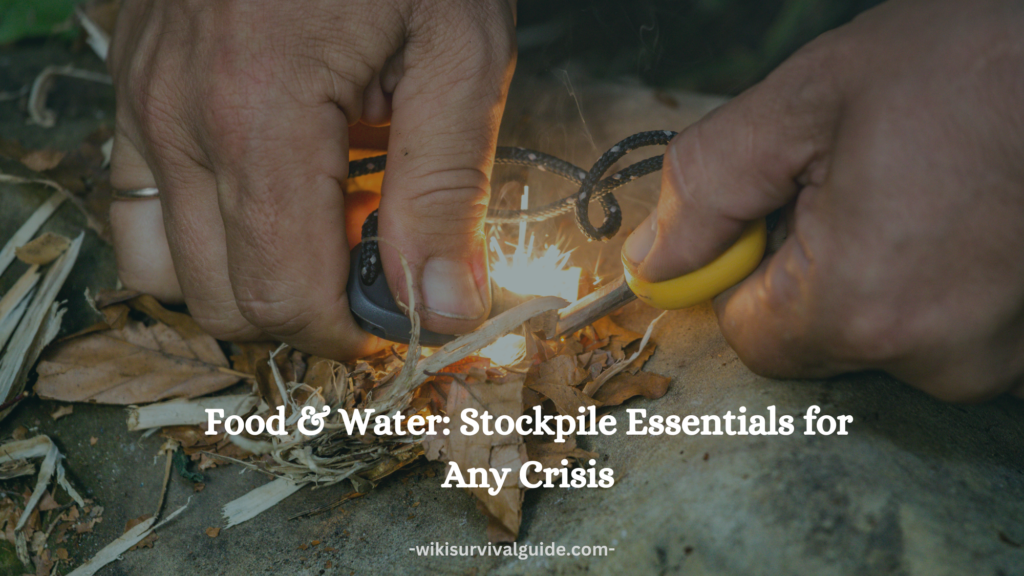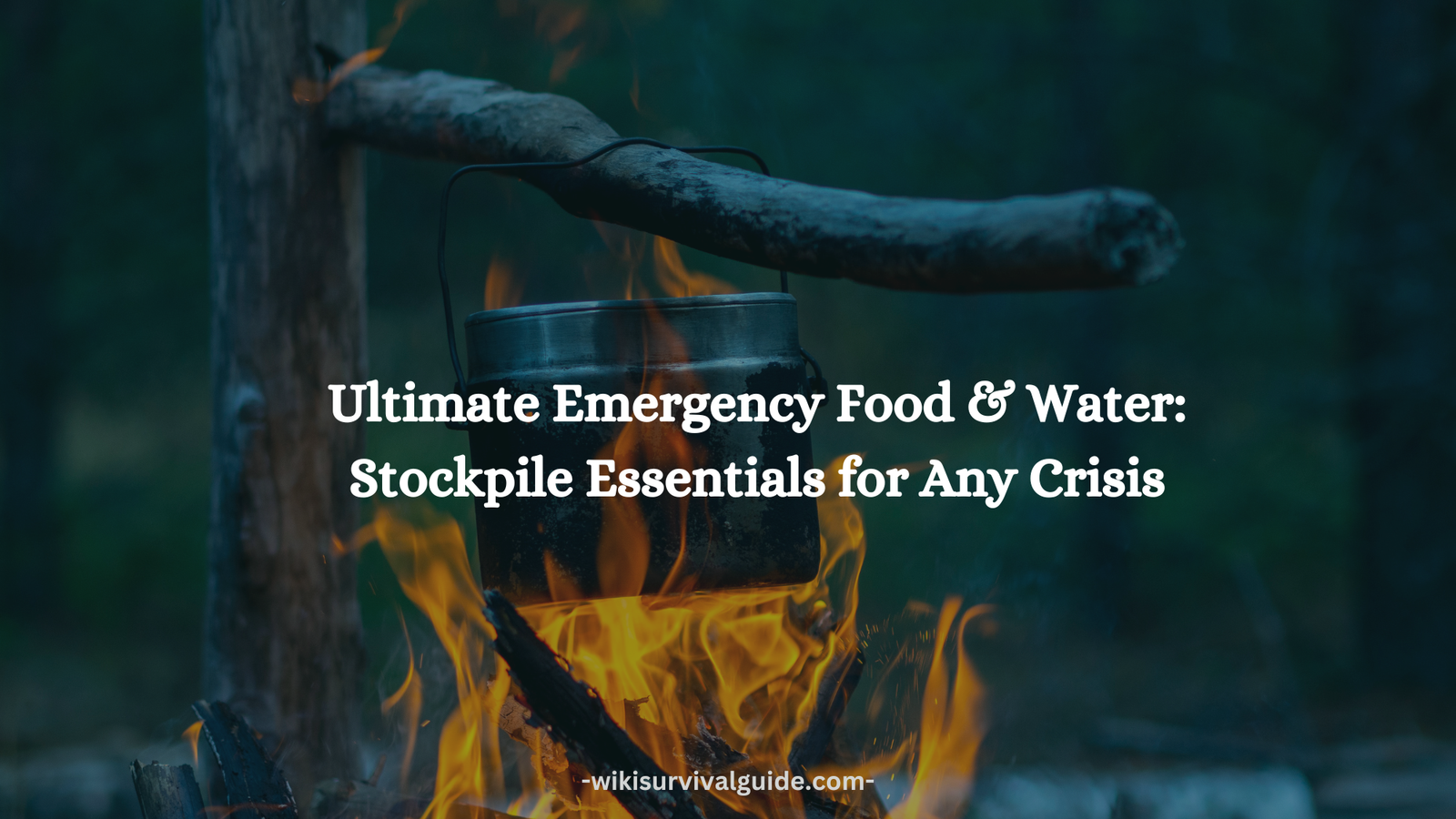Disasters can strike at any moment, whether it’s a power outage, natural disaster, or unforeseen emergency. In these situations, access to food and clean water becomes critical for survival. Without proper preparation, grocery store shelves empty quickly, and safe drinking water becomes scarce. That’s why having an emergency food and water stockpile is essential.
This guide on “Ultimate Emergency Food & Water: Stockpile Essentials for Any Crisis” will walk you through the best survival foods, long-term food storage solutions, and effective water purification methods.

Long-Term Food Storage Essentials
When planning for an emergency, long-term food storage is a critical aspect of preparedness. Stockpiling non-perishable, shelf-stable foods ensures that you and your family have access to essential nutrients during a crisis. The key to an effective long-term food supply is variety, nutrition, and proper storage methods.
One of the most important factors in long-term food storage is selecting foods with extended shelf lives. Staples such as rice, beans, oats, wheat, and pasta can last for decades when stored properly. Freeze-dried and dehydrated foods also have exceptional longevity, often lasting up to 25 years. Commercially packaged emergency food kits provide convenience, as they come pre-portioned and ready to use.
Storage conditions play a crucial role in preserving food quality. Keeping food in a cool, dark, and dry environment helps prevent spoilage. Airtight containers, Mylar bags, and oxygen absorbers are essential for protecting food from pests, moisture, and oxidation. Rotating stored food using the “first in, first out” method ensures that nothing expires before use.
Nutrition is another consideration. A well-balanced emergency food supply includes carbohydrates for energy, proteins for muscle maintenance, and fats for long-term satiety. Vitamins and minerals from canned vegetables, powdered milk, and multivitamins help prevent deficiencies.
In addition to food, it is essential to have the necessary tools for preparation. Manual can openers, cooking utensils, and non-electric stoves or solar ovens ensure that food remains accessible in power outages.
A carefully planned long-term food storage strategy can provide security and peace of mind during any crisis. Whether facing natural disasters, economic instability, or supply chain disruptions, having a well-stocked pantry ensures self-sufficiency and resilience.
Canned Goods for Survival
Canned foods are a cornerstone of any emergency food stockpile due to their long shelf life, ease of storage, and nutritional benefits. They provide a convenient way to ensure access to essential food groups without requiring refrigeration. Proper selection and storage of canned goods can significantly enhance the effectiveness of a survival food supply.
One of the biggest advantages of canned foods is their extended shelf life. Many canned goods, including vegetables, fruits, meats, and soups, can last for years beyond their expiration dates if stored properly. The airtight seal and vacuum packaging prevent bacteria and mold growth, ensuring that food remains safe to consume even in prolonged emergencies.
Canned meats such as tuna, chicken, spam, and corned beef provide high-quality protein sources that are crucial for maintaining strength and energy. Vegetables and fruits retain their vitamins and minerals, making them a vital component of a balanced diet. Canned beans, lentils, and chickpeas are excellent sources of both protein and fiber, promoting digestive health.
Storage conditions are essential in maintaining canned food quality. Keeping cans in a cool, dry, and dark place helps prevent degradation. Avoiding dented, rusted, or swollen cans is critical, as these can indicate bacterial contamination or compromised seals.
The versatility of canned foods makes them easy to use in various emergency meals. They can be eaten straight from the can, making them convenient when cooking is not an option. Additionally, they can be combined with rice, pasta, or bread to create more substantial meals.
Including a variety of canned goods in a survival stockpile ensures adequate nutrition and dietary diversity. Since they require minimal preparation and provide essential nutrients, they are one of the most reliable food sources for any emergency scenario.
Dehydrated and Freeze-Dried Meals
Dehydrated and freeze-dried meals are among the most efficient emergency food options due to their lightweight nature, long shelf life, and ease of preparation. They retain much of their original nutritional value while significantly reducing moisture content, preventing bacterial growth and spoilage.
The primary difference between dehydrated and freeze-dried foods lies in their processing methods. Dehydration involves removing water using heat, which can slightly alter texture and flavor. Freeze-drying, on the other hand, removes water by freezing and then using a vacuum process to sublimate ice into vapor, preserving the food’s structure and taste better. Both methods yield foods that can last anywhere from 10 to 30 years when properly stored.
One of the greatest advantages of these meals is their minimal weight. Unlike canned goods, which are bulky and heavy, dehydrated and freeze-dried foods are compact and easy to store. This makes them ideal for emergency preparedness, bug-out bags, and long-term survival planning.
These foods require only water to rehydrate, making them simple to prepare. Many commercially available freeze-dried meals, such as soups, pasta, and stews, come in pre-packaged pouches where you simply add hot water and wait a few minutes before eating. This convenience makes them perfect for situations where cooking resources may be limited.
From a nutritional standpoint, these meals provide a balanced combination of carbohydrates, proteins, and fats. Many brands fortify their products with vitamins and minerals to enhance overall health benefits. Freeze-dried fruits and vegetables retain nearly all their original nutrients, making them an excellent addition to any emergency food supply.
Proper storage is essential for maximizing shelf life. Keeping these foods in sealed Mylar bags with oxygen absorbers in a cool, dark, and dry environment ensures longevity. A well-stocked supply of dehydrated and freeze-dried meals offers peace of mind, ensuring access to nutritious and convenient food during any crisis.
High-Energy Snacks and Nutrition Bars
High-energy snacks and nutrition bars are essential additions to any emergency food stockpile, offering quick, convenient sources of calories and nutrients. These compact food items provide an instant energy boost, making them invaluable during crises where cooking or meal preparation is not possible.
Energy bars, protein bars, and granola bars are designed to deliver high-calorie content in a small package. They typically contain a mix of carbohydrates, proteins, and healthy fats to sustain energy levels. Some bars are formulated for specific needs, such as high-protein bars for muscle maintenance or electrolyte-infused bars for hydration support.
Nuts and seeds, such as almonds, walnuts, sunflower seeds, and peanuts, are excellent emergency food items due to their high protein and fat content. They are naturally long-lasting and do not require refrigeration. Similarly, dried fruits like raisins, apricots, and banana chips provide essential vitamins and natural sugars for quick energy.
Trail mix, which combines nuts, dried fruit, and sometimes chocolate or yogurt-covered pieces, is another great option. It provides a balanced mix of macronutrients while being easy to store and carry.
The portability of high-energy snacks makes them perfect for emergency kits, bug-out bags, and car supplies. They require no preparation, making them ideal for situations where food access is limited. Additionally, they can supplement meals by adding extra calories and nutrients to maintain energy levels.
Storage considerations are minimal, but it is best to keep these snacks in airtight containers or vacuum-sealed packaging to prevent spoilage. Regularly checking expiration dates and rotating stock ensures freshness. High-energy snacks and nutrition bars are reliable, lightweight, and versatile, making them indispensable for any survival plan.
Grains, Rice, and Pasta for Sustenance
Grains, rice, and pasta form the foundation of a well-balanced emergency food supply due to their long shelf life, affordability, and ability to provide sustained energy. These staple foods serve as excellent sources of carbohydrates, which are essential for fueling the body during crises.
Rice, particularly white rice, is one of the best survival foods due to its ability to last for decades when stored properly. Brown rice, though more nutritious, has a shorter shelf life because of its higher oil content. Quinoa, barley, and bulgur wheat are nutritious alternatives that provide additional protein and fiber.
Pasta is another valuable staple, as it is lightweight, non-perishable, and easy to cook. Whole wheat pasta offers added nutrients, while egg noodles and gluten-free options provide variety. Instant and quick-cook pastas are beneficial for emergency situations where fuel for cooking may be limited.
Grains such as oats, wheat berries, and cornmeal add diversity to an emergency food stockpile. They can be ground into flour, cooked as porridge, or used in baking. Whole grains tend to have longer shelf lives when stored in airtight containers with oxygen absorbers.
Storage is crucial for maximizing longevity. Keeping grains, rice, and pasta in sealed Mylar bags, food-grade buckets, or vacuum-sealed containers protects them from pests, moisture, and oxidation. Proper storage ensures these staples remain edible for years, providing a reliable foundation for emergency meals.
Protein Sources: Meat, Beans, and Dairy Alternatives
Protein is an essential component of any emergency food stockpile, playing a crucial role in maintaining muscle mass, immune function, and overall health. In long-term survival situations, a well-balanced supply of protein sources ensures that the body remains strong and nourished.
Canned and Freeze-Dried Meats
Canned meats such as chicken, tuna, salmon, and beef provide a reliable source of protein with extended shelf lives. They require no refrigeration and can be eaten straight from the can or added to other meals. Freeze-dried meats, including beef, chicken, and sausage crumbles, have even longer shelf lives, lasting up to 25 years when stored properly.
Dried and Shelf-Stable Beans
Beans and legumes, such as black beans, lentils, chickpeas, and kidney beans, are excellent plant-based protein sources. They are rich in fiber and essential nutrients, making them a vital part of a survival diet. Dried beans last indefinitely when stored in airtight containers with oxygen absorbers, while canned beans offer a convenient ready-to-eat option.
Dairy and Plant-Based Protein Alternatives
Powdered dairy products like whey protein, milk powder, and cheese powder provide essential protein and calcium. For those who prefer plant-based alternatives, soy protein, textured vegetable protein (TVP), and shelf-stable tofu are excellent options. These alternatives ensure dietary diversity and accommodate different dietary restrictions.
Shelf-Stable Dairy and Egg Products
Dairy and eggs are essential for a well-rounded diet, but their perishable nature makes storage challenging. Fortunately, several shelf-stable options allow for long-term storage while maintaining essential nutrients.
Powdered Milk and Dairy Products
Powdered milk is a survival staple, providing essential calcium, protein, and vitamins. It can be used for drinking, cooking, or baking. Other shelf-stable dairy products include powdered butter, cheese powder, and evaporated or condensed milk, all of which add flavor and nutrition to emergency meals.
Egg Powder and Freeze-Dried Eggs
Egg powder is a high-protein alternative that can be used in baking, scrambled eggs, or even as a binder in recipes. Freeze-dried eggs retain their original taste and texture when rehydrated, making them a versatile emergency food item.
Long-Lasting Dairy Alternatives
For those who are lactose intolerant or prefer non-dairy options, shelf-stable almond, soy, or coconut milk can be excellent substitutes. These products often come in aseptic packaging, extending their shelf life without refrigeration.
Sugars, Sweeteners, and Baking Essentials
Sugars and sweeteners play an important role in food preservation, energy supply, and enhancing flavors. Baking essentials also ensure that meals remain diverse and satisfying during emergencies.
Long-Lasting Sugars and Sweeteners
White sugar, brown sugar, and powdered sugar have indefinite shelf lives when stored in airtight containers. Honey, one of the best natural sweeteners, never spoils and has antibacterial properties. Maple syrup, molasses, and agave nectar provide additional sweetening options with distinct flavors.
Baking Staples for Emergency Cooking
Flour, baking powder, baking soda, and yeast are crucial for making bread, pancakes, and other baked goods. Whole wheat flour has a shorter shelf life due to its natural oils, while white flour lasts longer. Storing these essentials in Mylar bags with oxygen absorbers helps extend their usability.
Alternative Sweeteners for Special Diets
For those with dietary restrictions, artificial sweeteners like stevia, monk fruit, and erythritol offer low-calorie alternatives. These substitutes provide sweetness without affecting blood sugar levels, making them ideal for diabetics or those following low-carb diets.
Cooking Oils and Fats for Caloric Intake
Fats are a crucial component of an emergency food supply, providing essential calories, aiding in nutrient absorption, and adding flavor to meals. Choosing the right types of fats ensures long shelf life and nutritional benefits.
Best Oils for Long-Term Storage
Olive oil, coconut oil, and vegetable oils are commonly stored for emergency use. Coconut oil has the longest shelf life due to its natural antimicrobial properties. Olive oil, while nutritious, should be rotated regularly as it has a shorter lifespan.
Solid Fats for Extended Storage
Butter powder and ghee (clarified butter) are excellent alternatives to traditional butter, offering a longer shelf life without refrigeration. Lard and shortening are also great options for cooking and baking, as they remain stable for years when stored properly.
Nut and Seed Oils
Almond oil, sunflower oil, and flaxseed oil provide additional health benefits, including omega-3 fatty acids. However, these oils tend to go rancid faster than others, so they should be stored in cool, dark places and used within their recommended shelf lives.
Spices, Condiments, and Flavor Enhancers
Spices and condiments may seem like a luxury in emergency situations, but they are essential for maintaining morale and making food more enjoyable.
Essential Spices for Survival Cooking
Salt, pepper, garlic powder, onion powder, and chili powder are fundamental seasonings that enhance the flavor of basic survival foods. Herbs like basil, oregano, thyme, and rosemary provide variety and potential medicinal benefits.
Condiments with Long Shelf Lives
Soy sauce, vinegar, mustard, and hot sauce last for years and can dramatically improve the taste of simple meals. Honey and molasses double as sweeteners and natural preservatives.
Bouillon Cubes and Stock Powders
Bouillon cubes and powdered stocks add depth to soups, stews, and rice dishes. They are lightweight, compact, and rich in sodium, which helps maintain electrolyte balance in survival situations.
A well-rounded emergency food stockpile isn’t just about survival—it’s about maintaining nutrition, variety, and morale. By incorporating essential proteins, dairy, sweeteners, fats, and flavor enhancers, you ensure a balanced diet that sustains both body and mind during any crisis.
Emergency Water Storage Solutions
Water is the most critical resource for survival, making Emergency Food & Water storage a top priority. A well-planned water stockpile ensures access to clean, drinkable water in case of supply disruptions.
Short-Term and Long-Term Water Storage Options
For short-term emergencies, storing bottled water is a simple and effective solution. A general rule is to keep at least one gallon per person per day for drinking and sanitation. Long-term storage options include food-grade water barrels, stackable water containers, and underground cisterns. These options can store large quantities of water for months or even years when treated properly.
Water Storage Safety and Maintenance
Stored water should be kept in a cool, dark place away from chemicals and direct sunlight. Using water preservatives, such as sodium hypochlorite or commercial stabilizers, can extend water shelf life. Regularly rotating stored water ensures freshness, while sealed containers prevent contamination.
Rainwater Collection and Storage
Rainwater harvesting is an effective backup solution. Installing gutters, downspouts, and rain barrels allows the collection of free water, which can be filtered and purified for safe consumption. Proper filtration systems, such as first-flush diverters, help remove debris and contaminants.
Portable and Purification Water Filters
In emergencies where water sources are compromised, portable filtration devices ensure safe drinking water. Having a reliable water filter can mean the difference between hydration and illness.
Personal Water Filters for Emergency Use
Straw-style filters like the LifeStraw and Sawyer Mini allow direct drinking from natural water sources by removing bacteria, protozoa, and other contaminants. These lightweight and portable options are ideal for on-the-go survival.
Gravity and Pump-Based Filtration Systems
For larger groups, gravity-fed water filters, such as the Berkey system, provide high-capacity filtration without electricity. Hand-pump filters, like those from Katadyn, offer reliable purification by removing viruses and heavy metals.
UV and Advanced Filtration Methods
UV water purifiers, such as SteriPEN, use ultraviolet light to kill bacteria and viruses in seconds. Reverse osmosis systems, while less portable, offer the highest level of purification by filtering out nearly all contaminants, including chemicals and dissolved solids.
Water Purification Tablets and Treatments
Water purification tablets and chemical treatments are essential for emergency preparedness, providing a lightweight and effective way to disinfect water when filters are unavailable.
Chlorine and Iodine-Based Purification
Chlorine dioxide and iodine tablets effectively kill bacteria, viruses, and protozoa. While iodine leaves a distinct taste, it is a reliable option for short-term use. Chlorine dioxide tablets, such as Aquamira, provide a more neutral taste and better pathogen elimination.
Bleach as a Water Treatment Option
Household bleach (unscented, 5-6% sodium hypochlorite) can be used for water purification by adding 8 drops per gallon and allowing 30 minutes for disinfection. It should be stored properly and replaced annually.
Hydrogen Peroxide and Silver-Based Treatments
Silver-infused purification treatments extend water shelf life by preventing bacterial growth. Hydrogen peroxide is another option that acts as an oxidizing agent, though it should be used cautiously.
Hydration Supplements and Electrolytes
During emergencies, hydration isn’t just about water—maintaining electrolyte balance is crucial for preventing dehydration and fatigue, especially in hot climates or high-activity situations.
Electrolyte Powders and Tablets
Electrolyte powders, such as Liquid I.V. and DripDrop, quickly replenish sodium, potassium, and magnesium levels. These can be added to water to maintain hydration and prevent muscle cramps.
Coconut Water and Natural Rehydration Alternatives
Shelf-stable coconut water is a natural source of electrolytes, offering an alternative to artificial sports drinks. Dried fruits, like bananas and apricots, also provide potassium and magnesium to support hydration.
Oral Rehydration Solutions for Medical Needs
In severe dehydration cases, oral rehydration salts (ORS) mixed with water provide a medically-approved balance of glucose and electrolytes. These are essential for treating dehydration caused by illness, heat exposure, or strenuous activity.
Non-Electric Cooking and Food Preparation
In crisis situations where electricity is unavailable, alternative cooking methods are necessary for preparing meals and boiling water.
Fuel-Based Stoves and Burners
Portable propane and butane stoves offer efficient, controlled cooking options. Dual-fuel stoves, which run on gasoline or kerosene, provide additional versatility for extended emergencies.
Solar Ovens and Rocket Stoves
Solar ovens use sunlight to cook food slowly, making them an eco-friendly, fuel-free option. Rocket stoves are highly efficient, requiring only small amounts of wood or biomass to generate high heat for cooking.
DIY and Improvised Cooking Solutions
For survival situations, makeshift cooking solutions like open fire pits, Dakota fire holes, and improvised grills using cinder blocks or stones allow for meal preparation with minimal resources.
Having a well-thought-out emergency food and water plan ensures preparedness for any crisis, ensuring survival, nutrition, and safety when standard resources become unavailable.
Food Rotation and Expiration Management
A well-maintained food stockpile is only effective if its contents remain fresh and usable. Proper food rotation and expiration management ensure that emergency supplies are safe, nutritious, and readily available when needed.
First In, First Out (FIFO) Method
The FIFO method ensures that the oldest food is used first, preventing waste. Newer items should always be placed behind older ones so that the oldest food is consumed before it expires. This practice applies to both short-term and long-term food storage.
Labeling and Tracking Expiration Dates
Keeping an inventory list with expiration dates helps monitor stored food. Labeling containers with purchase and expiration dates makes it easy to identify which items need to be consumed or replaced. Digital spreadsheets or food storage tracking apps can further streamline the process.
Extending Shelf Life with Proper Storage
Temperature, humidity, and light exposure greatly impact food shelf life. Dry foods should be stored in airtight containers with oxygen absorbers to prevent spoilage. Canned goods should be kept in a cool, dark place to extend their usability. Vacuum sealing and Mylar bags provide extra protection for grains and dried foods.
Donating or Consuming Soon-to-Expire Food
Instead of letting food go to waste, items approaching expiration should be incorporated into meals or donated to local food banks. This ensures that food remains useful and benefits those in need.
Proper food rotation and expiration management are essential for maintaining a reliable emergency food supply, reducing waste, and ensuring that no resources are lost during a crisis.
DIY and Home-Preserved Foods
Preserving food at home is a cost-effective and sustainable way to build an emergency stockpile. Home-preserved foods often retain their nutrients better than store-bought options and allow for greater customization of flavors and ingredients.
Canning for Long-Term Preservation
Canning is one of the most effective methods for preserving food. Pressure canning is essential for low-acid foods like meats, beans, and vegetables, while water bath canning works well for acidic foods such as fruits, jams, and pickles. Properly sealed canned foods can last for years.
Dehydration and Freeze-Drying
Dehydrating removes moisture from food, making it lightweight and shelf-stable. Dried fruits, vegetables, and meats (jerky) retain their flavors and nutrients for extended periods. Freeze-drying, while requiring specialized equipment, preserves food for up to 25 years with excellent texture and taste retention.
Fermentation and Pickling
Fermented foods like sauerkraut, kimchi, and yogurt not only have long shelf lives but also provide probiotics that support gut health. Pickling vegetables in vinegar and salt solutions extends their usability while adding variety to meals.
Root Cellaring for Natural Storage
A root cellar offers a traditional, non-electric way to store fresh produce like potatoes, carrots, and apples. These environments maintain cool, stable temperatures that extend the life of stored foods without the need for refrigeration.
DIY food preservation ensures self-sufficiency and allows for a Emergency Food & Water steady supply of nutritious, home-prepared meals in any emergency scenario.
Compact and Lightweight Emergency Rations
For situations where space and portability are crucial, compact and lightweight emergency rations provide essential sustenance without taking up much room. These foods are ideal for bug-out bags, emergency kits, and on-the-go survival situations.
High-Calorie Survival Bars
Emergency food bars, such as Datrex and SOS Rations, are designed to provide high energy in a small package. These bars have a long shelf life, require no preparation, and are easy to store. They are formulated to sustain energy levels and provide essential nutrients during crises.
Meal Replacement and Energy Gels
Meal replacement shakes and energy gels offer quick nourishment without the need for cooking. These products are designed for endurance athletes but also serve as effective emergency rations. They provide balanced macronutrients and electrolytes in a convenient form.
Compressed and Vacuum-Sealed Meals
Military-style MREs (Meals Ready-to-Eat) and freeze-dried backpacking meals are excellent options for compact food storage. These meals are vacuum-sealed for long shelf life and often come with heating elements for on-the-go preparation.
Instant Foods and Powdered Meals
Instant oatmeal, soup mixes, and powdered meal replacements are lightweight options that require only water for preparation. These foods offer variety and convenience without compromising on nutrition.
Compact emergency rations ensure that food remains accessible, energy-dense, and easy to carry during any survival situation.
Infant, Elderly, and Special Dietary Needs
Emergency food planning must account for the unique dietary needs of infants, seniors, and individuals with medical conditions or dietary restrictions.
Baby Formula and Infant Food Storage
Infants rely on formula or breast milk, making powdered or ready-to-feed infant formula a critical component of any emergency food supply. Baby food jars, freeze-dried fruits, and infant cereals provide additional nutrition for young children.
Soft Foods and Nutritional Needs for Seniors
Elderly individuals may require soft, easy-to-chew foods. Applesauce, pudding cups, meal replacement drinks like Ensure, and rehydrated soups offer convenient nutrition for those with difficulty chewing or digesting solid foods. High-protein and fiber-rich options help maintain strength and digestion.
Gluten-Free, Vegan, and Allergy-Safe Foods
Individuals with dietary restrictions need suitable emergency food options. Gluten-free grains like quinoa and rice, plant-based protein sources, and allergen-free meal replacements ensure that everyone’s nutritional needs are met without health risks.
Diabetic and Low-Sodium Options
Diabetics require low-glycemic food choices such as unsweetened nut butters, protein bars, and whole grains. Low-sodium canned goods and unsalted nuts help those with hypertension maintain a balanced diet.
Tailoring an emergency food supply to meet diverse dietary needs ensures that all individuals, regardless of age or health condition, receive adequate nutrition during a crisis.
Bartering and Tradeable Food Items
In extended crises where normal supply chains break down, food can become a valuable trade currency. Stockpiling desirable tradeable items ensures the ability to barter for necessities.
High-Demand Bartering Foods
Non-perishable staples like rice, beans, flour, and sugar are always in demand. These basics can be easily divided and traded for other essential goods.
Luxury and Comfort Foods
Coffee, tea, chocolate, and canned meats are considered luxury items in emergencies. These comfort foods hold high barter value because they provide psychological relief in stressful situations.
Alcohol and Tobacco for Trade
Alcohol and cigarettes are common barter goods due to their scarcity during crises. Small bottles of liquor and sealed packs of cigarettes are easy to store and trade for essential supplies.
Spices and Condiments as Valuable Goods
Spices, salt, and sweeteners can enhance bland emergency meals and hold significant value in trade. Small packets of sugar, honey, or seasoning blends can be exchanged for other needed resources.
By including tradeable food items in an emergency stockpile, individuals can gain access to additional supplies and strengthen their position in survival situations.
Conclusion
No one wants to be caught off guard in a crisis. By preparing now, you ensure that when the unexpected happens, you have ultimate emergency food & water: stockpile essentials for any crisis ready to keep you and your family safe.
FAQs
- What are the best foods for long-term food storage?
Freeze-dried meals, canned goods, vacuum-sealed dry foods, and MREs last the longest. - How can I ensure my stored water remains safe to drink?
Rotate stored water every six months and use purification tablets or filters if needed. - What’s the difference between MREs and freeze-dried foods?
MREs are ready-to-eat, while freeze-dried meals require water rehydration. - How do I prevent my food from spoiling during long-term storage?
Store food in airtight containers in a cool, dark, and dry place.
Can I store tap water for emergencies, and if so, how?
Yes! Use clean, food-grade containers and add a few drops of unscented bleach per gallon for safety.




1 Comment